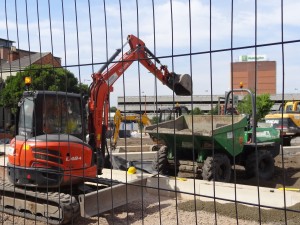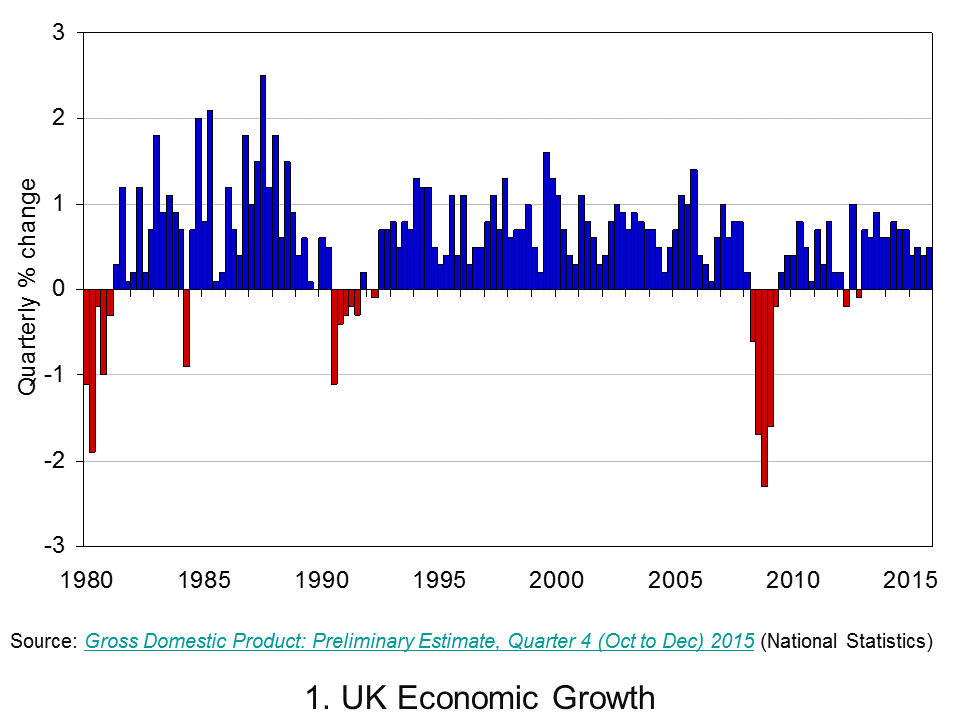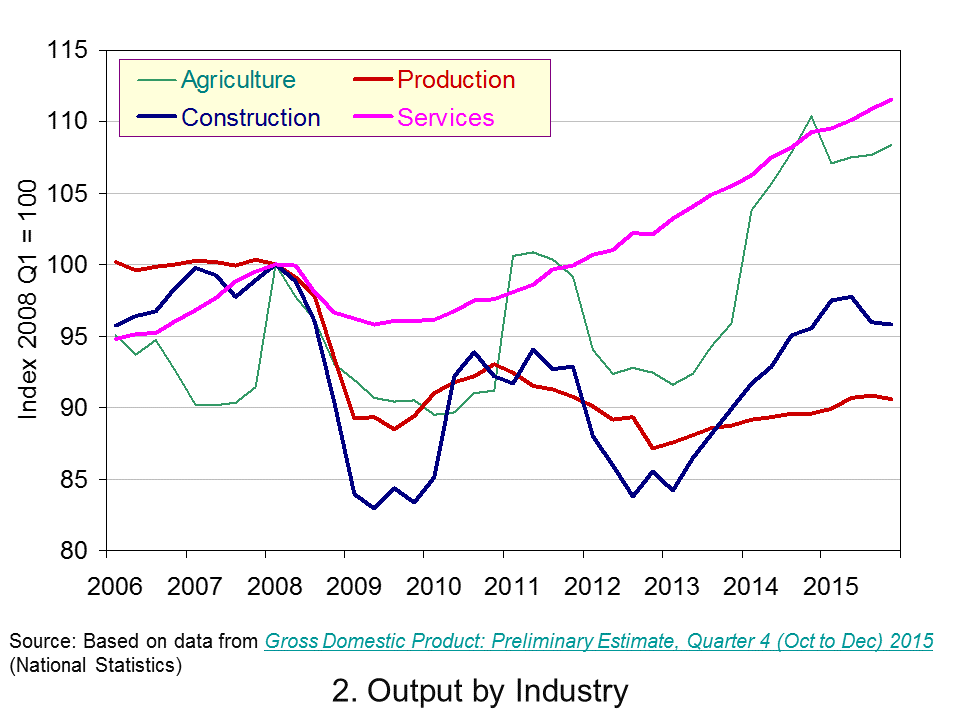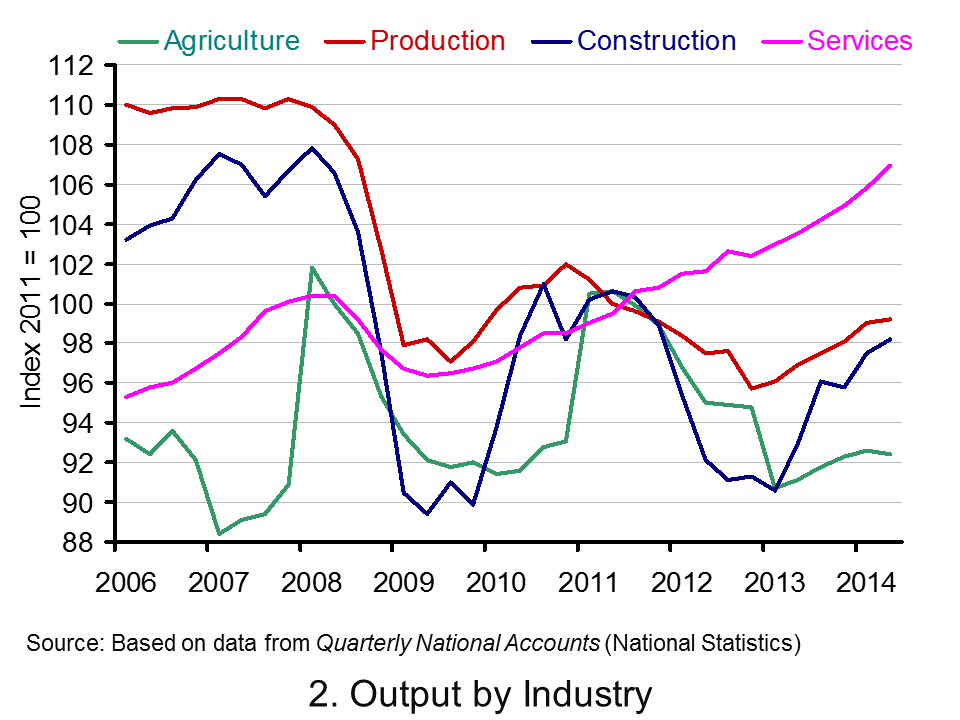 In our recent blog constructing growth without production: The UK growth paradox we saw that the provisional estimate of economic growth in the UK in the final quarter of 2015 was 0.5 per cent. This was buoyed by service sector growth of 0.7 per cent. Meanwhile, construction sector output was estimated to have fallen by 0.1 per cent and production in the production industries by 0.2 per cent. The ONS Index of Production released on 11 February suggests the decline in production activity in the final quarter might have been has much as 0.5 per cent further pointing to unbalanced industrial growth.
In our recent blog constructing growth without production: The UK growth paradox we saw that the provisional estimate of economic growth in the UK in the final quarter of 2015 was 0.5 per cent. This was buoyed by service sector growth of 0.7 per cent. Meanwhile, construction sector output was estimated to have fallen by 0.1 per cent and production in the production industries by 0.2 per cent. The ONS Index of Production released on 11 February suggests the decline in production activity in the final quarter might have been has much as 0.5 per cent further pointing to unbalanced industrial growth.
 The production industries today account for about 15 per cent of UK output which is small in comparison to the roughly 79 per cent from service-sector industries. Chart 1 shows the quarterly rate of growth in UK industrial production since the 1980s. (Click here for a PowerPoint of the chart). Over this period the average quarterly rate of growth in industrial output has been a mere 0.1 per cent compared with 0.5 per cent for total economic output and 0.7 per cent for the service sector. As a result, the importance of the production industries as a driver of economic output has declined.
The production industries today account for about 15 per cent of UK output which is small in comparison to the roughly 79 per cent from service-sector industries. Chart 1 shows the quarterly rate of growth in UK industrial production since the 1980s. (Click here for a PowerPoint of the chart). Over this period the average quarterly rate of growth in industrial output has been a mere 0.1 per cent compared with 0.5 per cent for total economic output and 0.7 per cent for the service sector. As a result, the importance of the production industries as a driver of economic output has declined.
Across 2015 industrial production rose by 1 per cent while the total output of the economy grew by 2.2 per cent. Industrial output comprises four main components. Of these, output from mining and quarrying grew in 2015 by 6.6 per cent, water, sewerage and waste management by 3.1 per cent, electricity, gas, steam and air conditioning by 0.3 per cent, while manufacturing output contracted by 0.2 per cent.
 Chart 2 shows the path of industrial output since 2006. (Click here for a PowerPoint of the chart). In particular, it allows us to analyse the effect of the financial crisis and the global economic downturn. Whereas the total output of the economy surpassed its 2008 Q1 peak in 2013 Q2, driven by the service sector, total industrial output in 2015 Q4 remains 9.9 per cent below its 2008 Q1 level. Among its component parts, output in mining and quarrying is 31 per cent lower, electricity, gas, steam and air conditioning output is 12.2 per cent lower and manufacturing 6.5 per cent lower. Only the output of water, sewerage and waste management is greater – some 7.4 per cent higher.
Chart 2 shows the path of industrial output since 2006. (Click here for a PowerPoint of the chart). In particular, it allows us to analyse the effect of the financial crisis and the global economic downturn. Whereas the total output of the economy surpassed its 2008 Q1 peak in 2013 Q2, driven by the service sector, total industrial output in 2015 Q4 remains 9.9 per cent below its 2008 Q1 level. Among its component parts, output in mining and quarrying is 31 per cent lower, electricity, gas, steam and air conditioning output is 12.2 per cent lower and manufacturing 6.5 per cent lower. Only the output of water, sewerage and waste management is greater – some 7.4 per cent higher.
The data point to the industrial composition of UK remaining heavily skewed towards the service sector and, hence, to service-sector industries driving economic growth. A key talking point is the extent to which this matters. On one hand we might point to the deindustrialisation captured by the data. This has had profound implications for certain regions of the United Kingdom and in particular for living standards in certain communities. Industrial change poses challenges for the UK labour force and for policymakers trying to affect the skills of workers needed in a changing economy. It has had a profound impact on the country’s balance of trade in goods: we consistently run a balance of trade deficit in goods. On the other hand we might argue that the UK does services well. We might be said to have a comparative advantage in this area. Whatever, your view point the latest industrial production data show the fragility of UK industrial output.
Data
Index of Production Dataset December 2015 Office for National StatisticsIndex of Production, December 2015 Office for National Statistics
Articles
UK industrial production shrank in 2015 Guardian, Phillip Inman (10/2/16)
December UK industrial output falls sharply BBC News, (10/2/16)
Manufacturing output fall dents UK growth hope Sky News, (10/2/16)
Industrial production’s worst monthly fall since 2012 Belfast Trelegraph, Holly Williams (11/2/16)
GDP growth picks up to 0.5% but only the services sector comes to the party Independent, Ben Chu (29/1/16)
Questions
- What is meant by industrial production? How does it differ from the economy’s total output?
- Would you expect the index of production to be less or more volatile than total output? Explain your answer.
- What factors might explain the volatility of industrial production?
- Do the different rates of growth across the industrial sectors of the UK matter?
- Discuss the economic issues that might arise as the industrial composition of a country changes.
- Why is the distinction between nominal and real important when analysing economic growth?
 In the blog the service sector continues to drive the UK business cycle written in October 2014 we observed how UK growth was being driven by the service sector while other industrial sectors struggled. The contrasting performance across UK industry appears now to be even more marked. The latest GDP numbers from the Office for National Statistics contained in Gross Domestic Product: Preliminary Estimate, Quarter 4 (Oct to Dec) 2015 show the economy’s output expanded by 0.5 per cent in the fourth quarter. Yet the construction sector is in recession following contractions of 1.9 per cent (Q3) and 0.1 per cent (Q4). Here we update our earlier blog to evidence the UK’s growth paradox.
In the blog the service sector continues to drive the UK business cycle written in October 2014 we observed how UK growth was being driven by the service sector while other industrial sectors struggled. The contrasting performance across UK industry appears now to be even more marked. The latest GDP numbers from the Office for National Statistics contained in Gross Domestic Product: Preliminary Estimate, Quarter 4 (Oct to Dec) 2015 show the economy’s output expanded by 0.5 per cent in the fourth quarter. Yet the construction sector is in recession following contractions of 1.9 per cent (Q3) and 0.1 per cent (Q4). Here we update our earlier blog to evidence the UK’s growth paradox.
Preliminary estimates suggest that the UK economy expanded by 0.5 per cent in the final quarter of 2015 following on from growth of of 0.4 per cent in the third quarter. 2015 as a whole saw output grow by 2.2 per cent, down from 2.9 per cent in 2014 and a little below the average over the past 60 years of around 2.6 per cent.
 Chart 1 shows quarterly economic growth since 1980s (Click here for a PowerPoint of the chart). It illustrates nicely the inherent volatility of economies – one of the threshold concepts in economics.The average quarterly rate of growth since 1980 has been 0.5 per cent so on the face of it, a quarterly growth number of 0.5 per cent might seem to paint a picture of sustainable growth. Yet, the industrial make up of growth is far from balanced.
Chart 1 shows quarterly economic growth since 1980s (Click here for a PowerPoint of the chart). It illustrates nicely the inherent volatility of economies – one of the threshold concepts in economics.The average quarterly rate of growth since 1980 has been 0.5 per cent so on the face of it, a quarterly growth number of 0.5 per cent might seem to paint a picture of sustainable growth. Yet, the industrial make up of growth is far from balanced.
 Consider now Chart 2 (Click here for a PowerPoint of the chart). It allows us to analyse more recent events by tracking how industrial output has evolved since 2006. It suggests an unbalanced recovery following the financial crisis. In 2015 Q4 the economy’s total output was 6.6 per cent higher than in 2008 Q1 with service-sector output 11.6 per cent higher. However, a very different picture emerges for the other principal industrial types.
Consider now Chart 2 (Click here for a PowerPoint of the chart). It allows us to analyse more recent events by tracking how industrial output has evolved since 2006. It suggests an unbalanced recovery following the financial crisis. In 2015 Q4 the economy’s total output was 6.6 per cent higher than in 2008 Q1 with service-sector output 11.6 per cent higher. However, a very different picture emerges for the other principal industrial types.
The economy’s total output surpassed its 2008 Q1 peak in 2013 Q2, but output across the production industries in 2015 Q4 remains 9.4 per cent lower than in 2008 Q1 (and 6.4 per cent lower specifically within manufacturing) and 4.2 per cent lower in the construction sector. However, output in the agricultural sector has rebounded and is now 8.4 per cent higher than in 2008 Q1.
The growth data continue to show the British economy struggling to rebalance its industrial composition. With output in construction in 2015 Q4 2 per cent lower than it was in Q2 and manufacturing output 0.4 per cent lower, UK growth remains stubbornly dependent on the service sector.
Data
Preliminary Estimate of GDP – Time Series Dataset Quarter 4 (Oct to Dec) 2015 Office for National StatisticsGross Domestic Product: Preliminary Estimate, Quarter 4 (Oct to Dec) 2015 Office for National Statistics
Economy tracker: GDP BBC News
Articles
UK economic growth slows in 2015: what the economists are saying Guardian, Katie Allen (28/1/16)
UK economy grows 0.5% in fourth quarter BBC News, (28/1/16)
Bumpy times ahead’ for UK even as fourth quarter growth accelerates Telegraph, Szu Ping Chan (28/1/16)
UK economic growth rises to 0.5% in fourth quarter The Scotsman, Roger Baird (28/1/16)
GDP growth picks up to 0.5% but only the services sector comes to the party Independent, Ben Chu (29/1/16)
Questions
- What is the difference between nominal and real GDP? Which of these helps to track changes in economic output?
- Looking at Chart 1 above, summarise the key patterns in real GDP since the 1980s.
- What is a recession?
- What are some of the problems with the traditional definition of a recession?
- Can a recession occur if nominal GDP is actually rising? Explain your answer.
- What factors lead to economic growth being so variable?
- What factors might explain the very different patterns seen since the late 2000s in the volume of output of the four main industrial sectors?
- What different interpretations could there be of a ‘rebalancing’ of the UK economy?
- What other data might we look at to analyse whether the UK economy is ‘rebalancing’?.
- Do the different rates of growth across the industrial sectors of the UK matter?
- Produce a short briefing paper exploring the prospects for economic growth in the UK over the next 12 to 18 months.
- What is the difference between GVA and GDP?
- Explain the arguments for and against using GDP as a measure of a country’s economic well-being.
 The latest GDP numbers from the Office for National Statistics contained in Quarterly National Accounts, Q2 2014 show the economy’s output expanded by 0.9 per cent in the second quarter. This follows on the back of a 0.7 per cent increase in output in Q1 2014. The economy’s output is now thought to be 0.7 per cent above its Q1 2008 peak. Yet, the data show very different profiles for the four principal industrial sectors. The service sector appears to be ploughing ahead while the rest (production, construction and agriculture) lag behind.
The latest GDP numbers from the Office for National Statistics contained in Quarterly National Accounts, Q2 2014 show the economy’s output expanded by 0.9 per cent in the second quarter. This follows on the back of a 0.7 per cent increase in output in Q1 2014. The economy’s output is now thought to be 0.7 per cent above its Q1 2008 peak. Yet, the data show very different profiles for the four principal industrial sectors. The service sector appears to be ploughing ahead while the rest (production, construction and agriculture) lag behind.
 Chart 1 shows quarterly economic growth since 1980s (click here for a PowerPoint of the chart). It illustrates nicely the inherent volatility of economies – one of the threshold concepts in economics. The average quarterly rate of growth since 1980 has been 0.5 per cent. On the face of it, a quarterly growth number of 0.9 per cent would appear very robust. Of course, this has to been set in the context of the 2008/9 recession. UK output peaked in Q1 2008 (£414.424 billion at 2011 prices). The revised data now show that there followed 5 quarters of declining output (previously, data suggested the duration of the recession was 6 quarters). During this period output shrank 6 per cent (GDP at 2011 prices had fallen by Q2 2009 to £389.388 billion ).
Chart 1 shows quarterly economic growth since 1980s (click here for a PowerPoint of the chart). It illustrates nicely the inherent volatility of economies – one of the threshold concepts in economics. The average quarterly rate of growth since 1980 has been 0.5 per cent. On the face of it, a quarterly growth number of 0.9 per cent would appear very robust. Of course, this has to been set in the context of the 2008/9 recession. UK output peaked in Q1 2008 (£414.424 billion at 2011 prices). The revised data now show that there followed 5 quarters of declining output (previously, data suggested the duration of the recession was 6 quarters). During this period output shrank 6 per cent (GDP at 2011 prices had fallen by Q2 2009 to £389.388 billion ).
Chart 1 highlights two earlier downturns. First, there is the recession of the early 1980s. We can see the 5-quarter recession that commenced in Q1 1980. By the end of this recession output had shrunk by 4.5 per cent. Second, there is the recession of the early 1990s which commenced in Q3 1990. Again, this recession lasted five quarters. By the time the economy had come out of recession it had shrunk 2.2 per cent.
 Consider now Chart 2 (click here for a PowerPoint of the chart). It allows us to analyse more recent events by tracking how industrial output has evolved since 2006. It suggests an unbalanced recovery. From it, we observe that in Q2 2014 service-sector output was 6.5 per cent higher than in Q1 2008. However, a very different picture emerges for the other principal industrial types. Output across the production industries remains 9.7 per cent lower, 9.2 per cent lower in agriculture and 8.9 per cent lower in the construction sector.
Consider now Chart 2 (click here for a PowerPoint of the chart). It allows us to analyse more recent events by tracking how industrial output has evolved since 2006. It suggests an unbalanced recovery. From it, we observe that in Q2 2014 service-sector output was 6.5 per cent higher than in Q1 2008. However, a very different picture emerges for the other principal industrial types. Output across the production industries remains 9.7 per cent lower, 9.2 per cent lower in agriculture and 8.9 per cent lower in the construction sector.
In short, the British economy continues to struggle to rebalance its industrial base. The business cycle remains heavily dependent on the service sector.
Articles
UK GDP revised up: what the economists say Guardian, Katie Allen (30/9/14)
UK economy grew 0.9% in second quarter, says ONS BBC News, Katie Allen (9/5/14)
UK GDP: Did the UK economy do well after all? Independent, Ben Chu (30/9/14)
UK economy grew 0.9% Herald, Ian McConnell (1/10/14)
Economy tracker: GDP BBC News (30/9/14).
Data
Quarterly National Accounts, Q2 2014 Dataset Office for National StatisticsQuarterly National Accounts, Q2 2014, Statistical Release Office for National Statistics
Questions
- What is the difference between nominal and real GDP? Which of these helps to track changes in economic output?
- Looking at Chart 1 above, summarise the key patterns in real GDP since the 1980s.
- What is a recession?
- What are some of the problems with the traditional definition of a recession?
- Can a recession occur if nominal GDP is actually rising? Explain your answer.
- What factors lead to economic growth being so variable?
- What factors might explain the very different patterns seen since the late 2000s in the volume of output of the four main industrial sectors?
- What different interpretations could there be of a ‘rebalancing’ of the UK economy?
- What other data might we look at to analyse whether the UK economy is ‘rebalancing’?.
- Produce a short briefing paper exploring the prospects for economic growth in the UK over the next 12 to 18 months.
- What is the difference between GVA and GDP?
- Explain the arguments for and against using GDP as a measure of a country’s economic well-being.
 In our recent blog constructing growth without production: The UK growth paradox we saw that the provisional estimate of economic growth in the UK in the final quarter of 2015 was 0.5 per cent. This was buoyed by service sector growth of 0.7 per cent. Meanwhile, construction sector output was estimated to have fallen by 0.1 per cent and production in the production industries by 0.2 per cent. The ONS Index of Production released on 11 February suggests the decline in production activity in the final quarter might have been has much as 0.5 per cent further pointing to unbalanced industrial growth.
In our recent blog constructing growth without production: The UK growth paradox we saw that the provisional estimate of economic growth in the UK in the final quarter of 2015 was 0.5 per cent. This was buoyed by service sector growth of 0.7 per cent. Meanwhile, construction sector output was estimated to have fallen by 0.1 per cent and production in the production industries by 0.2 per cent. The ONS Index of Production released on 11 February suggests the decline in production activity in the final quarter might have been has much as 0.5 per cent further pointing to unbalanced industrial growth. The production industries today account for about 15 per cent of UK output which is small in comparison to the roughly 79 per cent from service-sector industries. Chart 1 shows the quarterly rate of growth in UK industrial production since the 1980s. (Click here for a PowerPoint of the chart). Over this period the average quarterly rate of growth in industrial output has been a mere 0.1 per cent compared with 0.5 per cent for total economic output and 0.7 per cent for the service sector. As a result, the importance of the production industries as a driver of economic output has declined.
The production industries today account for about 15 per cent of UK output which is small in comparison to the roughly 79 per cent from service-sector industries. Chart 1 shows the quarterly rate of growth in UK industrial production since the 1980s. (Click here for a PowerPoint of the chart). Over this period the average quarterly rate of growth in industrial output has been a mere 0.1 per cent compared with 0.5 per cent for total economic output and 0.7 per cent for the service sector. As a result, the importance of the production industries as a driver of economic output has declined.  Chart 2 shows the path of industrial output since 2006. (Click here for a PowerPoint of the chart). In particular, it allows us to analyse the effect of the financial crisis and the global economic downturn. Whereas the total output of the economy surpassed its 2008 Q1 peak in 2013 Q2, driven by the service sector, total industrial output in 2015 Q4 remains 9.9 per cent below its 2008 Q1 level. Among its component parts, output in mining and quarrying is 31 per cent lower, electricity, gas, steam and air conditioning output is 12.2 per cent lower and manufacturing 6.5 per cent lower. Only the output of water, sewerage and waste management is greater – some 7.4 per cent higher.
Chart 2 shows the path of industrial output since 2006. (Click here for a PowerPoint of the chart). In particular, it allows us to analyse the effect of the financial crisis and the global economic downturn. Whereas the total output of the economy surpassed its 2008 Q1 peak in 2013 Q2, driven by the service sector, total industrial output in 2015 Q4 remains 9.9 per cent below its 2008 Q1 level. Among its component parts, output in mining and quarrying is 31 per cent lower, electricity, gas, steam and air conditioning output is 12.2 per cent lower and manufacturing 6.5 per cent lower. Only the output of water, sewerage and waste management is greater – some 7.4 per cent higher. 




